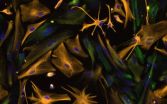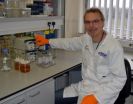(Press-News.org) Giving intravenous magnesium to stroke patients soon after the start of symptoms, in an attempt to protect brain cells deprived of oxygen, failed to improve stroke-related disability 3 months later, according to research presented at the American Stroke Association's International Stroke Conference 2014.
Investigators showed that paramedics can successfully deliver intravenous medications to most stroke patients within an hour after symptoms begin. This is the "golden hour" the time in which patients have the best chance to survive and avoid long-term neurological damage.
"We hoped magnesium would be beneficial, but in any case the study was a success in demonstrating we can get a drug to patients in this early time frame when there is the greatest amount of threatened brain tissue that might still be saved. There are lots of other promising agents in the pipeline that could be helpful and we now have a system for testing and using them," said Jeffrey L. Saver, M.D., principal investigator and professor of neurology and director of the stroke center at UCLA.
Currently, the only immediate treatment for clot-caused strokes is the clot-dissolving medication tissue plasminogen activator (tPA). However, this drug can't be given until the patient arrives at the hospital and a clot is confirmed by CT scan or other imaging.
"Giving tPA in the ambulance before brain imaging is not an option – it could harm patients having a bleeding type of stroke. Neuroprotective drugs can be delivered in the field as they are safe for both types of stroke," Saver said.
The Field Administration of Stroke Therapy – Magnesium Phase 3 Clinical Trial (FAST-MAG) tested whether IV magnesium, a potential neuroprotective agent, could be delivered in a timely manner and was effective in improving the neurological outcome of patients. Magnesium was chosen because, in animal studies, it dilates blood vessels in the brain, increasing blood flow, and counters the dangerous calcium overload that occurs in cells that are deprived of oxygen. In smaller human trials, magnesium given up to 12 hours after a stroke showed neither harm nor benefit overall, but there were indications that it was helpful in the small number of patients who received it within a few hours of stroke onset.
In the current study, IV magnesium proved to be safe, resulting in no more serious adverse reactions than placebo infusions. However, there was no benefit in outcome. Ninety days after the stroke, the average level of disability in both magnesium and placebo patients was 2.7 on the modified Rankin scale, indicating between a slight and moderate level of disability in which patients are unable to carry out their previous activities without assistance.
FAST-MAG involved collaboration between 315 ambulances, 40 emergency medical service agencies, 60 receiving hospitals, and 2,988 paramedics in Los Angeles and Orange Counties in California. Between 2005 and 2012, paramedics evaluated and began infusions of study medications to 1,700 patients (42.7 percent female, average age 69) within 2 hours of symptom onset.
In the study, the median time for receiving treatment was 45 minutes after symptoms began, and 74 percent of patients were started on treatment within an hour.
"The FAST-MAG investigators are enormously indebted to the paramedics who implemented the trial and showed incredible skill and dedication as first responders for this devastating brain condition," Saver said.
"Similarly the National Institute of Neurological Disorders and Stroke (NINDS) is extremely grateful to the investigators, emergency medical technicians, and patients who participated in this landmark study demonstrating how to test therapies in stroke patients before they arrive at the hospital," said Walter Koroshetz, M.D., Deputy Director of the NIH NINDS, the sponsor of the FAST-MAG study. "NINDS has just set up a new national stroke trials network which can incorporate the lessons learned in FAST-MAG, but also increase the likelihood that the treatments we test will improve patients' lives."
INFORMATION:
Co-authors are Marc Eckstein, M.D.; Samuel Stratton, M.D., M.P.H.; Frank Pratt, M.D.; Scott Hamilton, Ph.D.; Robin Conwit, M.D.; David Liebeskind, M.D.; Patrick Lyden, M.D.; Nerses Sanossian, M.D.; Gene Sung, M.D.; Ian Kramer, M.D.; Gary Moreau, M.D.; Robert Goldweber, M.D.; and Sidney Starkman, M.D.; writing for the FAST-MAG investigators and coordinators.
Author disclosures are on the abstract.
Downloadable video/audio interviews, B-roll, animation and images related to this news release are located on the right column of the release link located at http://newsroom.heart.org/news/ambulance-magnesium-treatment-fails-to-improve-stroke-outcome?preview=61dca0f34d1dd42e05b1507a422f4323.
Video clips with researchers/authors of the studies will be added to the release link after embargo.
Follow news from ASA International Stroke Conference 2014 via Twitter: @HeartNews #ISC14.
Get more information on:
Acute ischemic stroke guidelines
Stroke treatments
Stroke systems of care
Statements and conclusions of study authors that are presented at American Stroke Association scientific meetings are solely those of the study authors and do not necessarily reflect association policy or position. The association makes no representation or warranty as to their accuracy or reliability. The association receives funding primarily from individuals; foundations and corporations (including pharmaceutical, device manufacturers and other companies) also make donations and fund specific association programs and events. The association has strict policies to prevent these relationships from influencing the science content. Revenues from pharmaceutical and device corporations are available at http://www.heart.org/corporatefunding.
Note: Actual presentation is 11 a.m. PT, Thursday, February 13, 2014.
Ambulance magnesium treatment fails to improve stroke outcome
Abstract: 214 (rm. 27)
2014-02-13
ELSE PRESS RELEASES FROM THIS DATE:
New stem cell method may eliminate need for blood donations to maintain platelet supply
2014-02-13
Platelets, whose primary function is to prevent bleeding, are vital for treating various forms of trauma and blood diseases. However, they can only be obtained through blood donations at present. Researchers reporting online February 13 in the Cell Press journal Cell Stem Cell recently found a way to create platelets without the need for donated blood, an advance that could possibly erase supply shortages and ensure platelet treatments for all who need them.
The supply of donated platelets, which have a short shelf life and must be kept at room temperature, is often ...
Could action video games help people with dyslexia learn to read?
2014-02-13
In addition to their trouble with reading, people with dyslexia also have greater difficulty than typical readers do when it comes to managing competing sensory cues, according to a study reported February 13 in Current Biology, a Cell Press publication. The findings suggest that action video games might improve literacy skills in those with dyslexia, which represent five to ten percent of the population.
"Imagine you are having a conversation with someone when suddenly you hear your name uttered behind you," says Vanessa Harrar of the University of Oxford. "Your attention ...
Is zinc the missing link for osteoarthritis therapies?
2014-02-13
Osteoarthritis is a leading cause of disability, characterized by the destruction of cartilage tissue in joints, but there is a lack of effective therapies because the underlying molecular causes have been unclear. A study published by Cell Press February 13th in the journal Cell reveals that osteoarthritis-related tissue damage is caused by a molecular pathway that is involved in regulating and responding to zinc levels inside of cartilage cells. A protein called ZIP8 transports zinc inside these cells, setting off a cascade of molecular events that result in the destruction ...
Science is used to reveal masterpiece's true colors
2014-02-13
Scientists are using powerful analytical and imaging tools to study artworks from all ages, delving deep below the surface to reveal the process and materials used by some of the world's greatest artists.
Northwestern University chemist Richard P. Van Duyne, in collaboration with conservation scientists at the Art Institute of Chicago, has been using a scientific method he discovered nearly four decades ago to investigate masterpieces by Pierre-Auguste Renoir, Winslow Homer and Mary Cassatt.
Van Duyne recently identified the chemical components of paint, now partially ...
Conservation science partnership thrives, expands
2014-02-13
For nearly a decade, Northwestern University and the Art Institute of Chicago have been partners in conservation science, unlocking secrets about many of the museum's masterpieces -- by Pierre-Auguste Renoir, Pablo Picasso, Henri Matisse, Winslow Homer, George Seurat, Mary Cassatt and others -- and developing new methods and technologies to investigate art.
Last year, a $2.5 million grant from the Andrew W. Mellon Foundation established the Northwestern University/Art Institute of Chicago Center for Scientific Studies in the Arts (NU-ACCESS), a new national model of ...
Protein switch dictates cellular fate: stem cell or neuron
2014-02-13
Researchers at the University of California, San Diego School of Medicine have discovered that a well-known protein has a new function: It acts in a biological circuit to determine whether an immature neural cell remains in a stem-like state or proceeds to become a functional neuron.
The findings, published in the February 13 online issue of Cell Reports, more fully illuminate a fundamental but still poorly understood cellular act – and may have significant implications for future development of new therapies for specific neurological disorders, including autism and ...
Marriage's 'haves' and 'have nots'
2014-02-13
EVANSTON, Ill. --- Today Americans are looking to their marriages to fulfill different goals than in the past — and although the fulfillment of these goals requires especially large investments of time and energy in the marital relationship, on average Americans are actually making smaller investments in their marital relationship than in the past, according to new research from Northwestern University.
Those conflicting realities don't bode well for the majority of marriages, according to Eli Finkel, professor of psychology in the Weinberg College of Arts and sciences ...
Why did the orangutan come down from the trees?
2014-02-13
Orang-utans come down from the trees and spend more time on the ground than previously realised – but this behaviour may be partly influenced by man, a new study has found.
Dr Mark Harrison, based in the Department of Geography at the University of Leicester and Managing Director of the Orang-utan Tropical Peatland Project (OuTrop) has, along with international colleagues, published results of a seven year study of orang-utans in Borneo in the journal Scientific Reports.
The research, conducted between June 2006 and March 2013, is based on a large-scale analysis of ...
Plants recycle too
2014-02-13
Cells communicate through proteins embedded in their cell membranes. These proteins have diverse functions and can be compared with antennas, switches and gates. For the well-being of the cell, it has to adjust the composition of its membrane proteins and lipids constantly. New proteins are incorporated, while old proteins get recycled or eliminated. The process by which membrane material gets internalized is called endocytosis. A research team headed by Daniël van Damme and Geert De Jaeger from VIB and Ghent University (Belgium), and Staffan Persson from the Max Planck ...
How bacteria communicate with us to build a special relationship
2014-02-13
Communication is vital to any successful relationship. Researchers from the Institute of Food Research and the University of East Anglia have discovered how the beneficial bacteria in our guts communicate with our own cells.
This is a key step in understanding how our bodies maintain a close relationship with the population of gut bacteria that plays crucial roles in maintaining our health, fighting infection and digesting our food.
A study, published in the journal Cell Reports, shows that the gut bacteria produce an enzyme that modifies signalling in cells lining the ...
LAST 30 PRESS RELEASES:
Post-stroke injection protects the brain in preclinical study
Cardiovascular risk score predicts multiple eye diseases
Health: estimated one in ten British adults used or interested in GLP-1 medications for weight loss
Exercise to treat depression yields similar results to therapy
Whooping cough vaccination for pregnant women strengthens babies’ immune system
Dramatic decline in new cases of orphanhood in Uganda driven by HIV treatment and prevention programs
Stopping weight loss drugs linked to weight regain and reversal of heart health markers
Higher intake of food preservatives linked to increased cancer risk
Mass General Brigham–developed cholera vaccine completes phase 1 trial
First experimental validation of a “150-year-old chemical common sense” direct visualization of the molecular structural changes in the ultrafast anthracene [4+4] photocycloaddition reaction
Lack of support for people on weight loss drugs leaves them vulnerable to nutritional deficiencies, say experts
Dogs’ dinners can have greater climate impact than owners’
Are you ready to swap salmon for sprats and sardines?
1.6 million UK adults used weight loss drugs in past year
American College of Cardiology comments on new dietary guidelines for Americans
American Society of Gene & Cell Therapy and Orphan Therapeutics Accelerator partner to advance and commercialize promising rare disease treatments
One in 14 patients having day case surgery have new or worse chronic pain 3 months after their operation
New study highlights link between eviction rates and gun violence
Heatwaves heat up soil but not toxin levels in rice, study finds
Digital modeling reveals where construction carbon emissions really come from
Turning farm waste into water filters
New study shows how the spleen helps the immune system accept a transplant
New Mayo Clinic study advances personalized prostate cancer education with an EHR-integrated AI agent
Researchers identify novel therapeutic target to improve recovery after nerve injury
Microbes in breast milk help populate infant gut microbiomes
Reprogramming immunity to rewrite the story of Type 1 diabetes
New tool narrows the search for ideal material structures
Artificial saliva containing sugarcane protein helps protect the teeth of patients with head and neck cancer
Understanding the role of linear ubiquitination in T-tubule biogenesis
Researchers identify urban atmosphere as primary reservoir of microplastics
[Press-News.org] Ambulance magnesium treatment fails to improve stroke outcomeAbstract: 214 (rm. 27)


